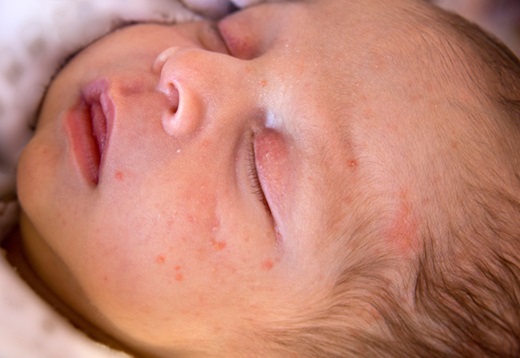Newborn Skin 101
Odd rashes, suspicious crusting and bumps that crop up from out of the blue are all common afflictions of newborn skin that rarely portend something ominous and are easy to treat. Yet, they have scared many first-time parents into calling their pediatrician after hours or rushing to the emergency room.

“Neonatal rashes tend to develop suddenly and have a dramatic appearance that can easily frighten a rookie parent, but luckily most of these are completely benign,” says Johns Hopkins Children’s Center dermatologist Kate Püttgen, M.D.
Offering her dual expertise as a mom and pediatric dermatologist, Püttgen discusses newborn skin care and the most common skin problems in newborns.
Cradle cap
What is it?
Neonatal dandruff, also known as seborrheic dermatitis, is extremely common but the cause isn’t fully known. It tends to occur in areas rich in oil glands in the first three months of life.
How to treat?
Most cases of cradle cap require nothing more than gentle washing and observation and clear up on its own. Petroleum jelly or olive oil can help relieve some of the crusting.
When to call the pediatrician?
If crusting persists or gets worse over time, your pediatrician may prescribe an antifungal cream or shampoo.
Diaper rash
What is it?
Skin irritation marked by red inflamed patches or bumps on baby’s buttocks and genital area. Fungal infections can cause diaper rash . Another common cause is skin inflammation caused by exposure to stool and urine. Harsh soaps, sweat, moisture or diapers that are too tight can also cause a rash or worsen an existing rash.
How to prevent and treat?
Change diapers often and as soon as the baby urinates or has a bowel movement. Wash your hands before and after you do so. Always dry baby’s skin thoroughly. Applying petroleum jelly or zinc oxide-based cream with each diaper change can be helpful. Never use talcum powder. Avoid perfumed baby wipes or wipes that contain alcohol. Keep the diapers loose. An antifungal or mild corticosteroid cream used for short periods can speed up healing.
When to call the pediatrician?
If the rash doesn’t get better within a few days, spreads further, becomes oozy or if your baby develops fever — a sign of infection — it’s time to see a doctor. A fungal infection should be suspected in all babies taking antibiotics, which can disrupt the balance between good and bad bacteria and cause yeast overgrowth.
Erythema toxicum
What is it?
A benign condition that affects the majority of newborns in the first days and weeks of life. Hallmark signs of the condition are yellowish papules surrounded by red skin on the face and trunk, upper arms and thighs.
How to treat?
Typically no treatment is needed. The rash will clear up on its own within a few weeks.
When to call the pediatrician?
If your baby has signs of erythema toxicum, an exam can confirm the diagnosis and provide reassurance.
Skincare
The basic rules of neonatal skincare, Püttgen says, are “less is more” and “bland and simple.”
Less is more
Babies don’t need an elaborate skin care regimen and barely any products. Keep bathing to a minimum to avoid stripping the skin of its protective natural oils. A bath twice or three times a week is sufficient.
Bland and simple
Baby skin is highly absorbent so it’s critical to use fragrance-free, hypo-allergenic products. Avoid perfumes and dyes, which can seriously irritate newborn skin.
Extra-fragile preemie skin warrants special attention. Premature skin does not hold moisture well, which makes it thinner, drier and breakage-prone, Püttgen says. She recommends applying petroleum jelly daily to lock in moisture and strengthen the skin’s barrier function.
Sun protection
Sun protection is another topic that causes a lot of confusion, Püttgen says. “Parents know that sun protection is critical, yet many are hesitant to use sunscreens,” she says.
Avoiding sun exposure is the best protection, Püttgen says. Use physical barriers like clothing, hats and stroller covers anytime you take baby outside. Sunscreens, though generally harmless, should be avoided when possible because the Food and Drug Administration has not studied their safety in infants under 6 months of age.
If sun exposure cannot be avoided, opt for fragrance-free, hypo-allergenic sunscreens that list zinc oxide and/or titanium dioxide as active ingredients. Known as physical sunscreens, these two ingredients block UV rays. By contrast, chemical sunscreens with active ingredients like octylcrylene, avobenzone, octinoxate, mexoryl and octisalate, tend to absorb and “disarm” UV rays before they can damage the skin.






